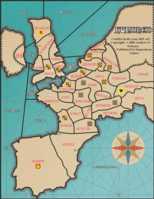 |  |  |


In the Summer of 2000, Stupendous Games published commercial versions of three Diplomacy variants: Ard-Ri (designed by Stuart John Bernard), Classical Diplomacy (designed by Vincent Mous and Andy Schwarz) and Hundred (designed by Andy Schwarz), representing the first time in almost 20 years that somebody other than the company holding the rights to Diplomacy has commercially published a Diplomacy variant. All three of these variants came out of the PBEM Diplomacy community. Hundred, in particular, is among the more popular variants in the PBEM Diplomacy community.
First Impressions
The first thing you'll note when you see the games is that they come not in boxes, but in "zip lock" bags. There is no rulebook enclosed. Stupendous Games' release of these variants is an independent effort, not done with Avalon Hill's (Hasbro's) endorsement or approval. Since Hasbro holds the copyrights associated with Diplomacy, these variants do not include the actual rules to Diplomacy. All three of the variants have some variant-specific rules, which are on the back of the single sheet in the bag.
So when you pick up one of these games, open a bag rather than a box, remove the contents and note the absence of a rulebook, the first thing that may come to mind is "Oh... looks like an amateur effort." Well, in defense of Stupendous Games, it's a low budget venture because it had to be. Stupendous Games does not have a manufacturing facility of their own. They lack some of the broad distribution channels that "mainstream" companies have, and probably have neither the initial capital nor expected sales to justify a huge production run that might have kept costs down through mass production. It's a small independent company which farmed out manufacturing for game parts (boards and counters), and self-published a game in what is relatively small batches. Doing that while keeping prices low enough so that people will buy the games is not easy. They could have designed a nice box to go with the game, but the additional cost to them would have forced higher prices to the customer. And to be honest, they had to be a bit conservative with pricing since you aren't actually buying a complete Diplomacy game... just a variant.
So yes, cost was kept in mind in producing this game, in an effort to make the final cost as affordable to as many people as possible. Have that first reaction at first glance, and then get past it. Although these games were produced on a budget, as you look further you'll see that they are not cheaply made.
What You See and What You Get
What you do get with the games is a gameboard (the map), variant rules, a set of die-cut cardboard counters, and a set of conference maps.The cardboard counters are not "units"; they have symbols/flags for the various powers and placed over the supply center marks on the gameboard to indicate changes in supply center ownership as the game progresses.The game does not come with army and fleet pieces, but since most players already own Diplomacy (and can use nondescript tokens or pieces from any game, really) this is not too much of an issue. As mentioned above, the rules to Diplomacy are not included, players need to own an existing copy of Diplomacy for the rules (or at least they have to know the rules and be willing to substitute something else for pieces). The conference maps are printed on a heavy paper stock, and people will probably want to make photocopies of them rather than use the included ones for writing on.
The gameboards come in several pieces that are placed side-by-side to create the full map (four sections for Ard-Ri and Hundred, and eight sections for Classical which has a considerably larger map). The gameboard is printed on a cardboard stock, thinner than the board in a typical boardgame, but quite nice looking. In fact, because of the thickness I wasn't sure how the assembled board would end up looking and as it turns out it ended up looking considerably better than I had initially expected. Although it isn't essential, it would probably be useful to have something to hold the sections together while you play. I remember a while back office supply stores selling plastic "bindings" that were the length of the long side of a sheet of paper, into which you could slide a dozen or so sheets of paper (with or without a clear plastic cover). Those little plastic sliders cost practically nothing, and one or two of them cut into smaller pieces would do just fine to hold adjacent sections of the gameboard together when you are playing the game. (If you have an older Avalon Hill bookcase edition of Diplomacy with a three-section gameboard, the sliders that they included to hold the sections together is exactly the same idea.) I plan on picking up a couple if I can find them.
To give an idea of the map style, the maps for the three variants are shown below (click on any of the images to see a larger map at the Stupendous Games web site). This is what the gameboard designs look like even though these are jpeg images and not scans of an actual gameboard. Note, however, that the actual physical gameboards themselves look quite a bit nicer than these images (even the larger versions) portray, as the maps are printed with a glossy finish and unfortunately the jpeg images shows the colors as being somewhat more muted than they really are.
 |  |  |
Worth Buying?
Ard-Ri and Hundred cost $15 each; Classical costs $20. Classical costs a bit more because it comes with a significantly larger map that comes in eight sections rather than the four required for Ard-Ri and Hundred. All three of the variants have a few special rules, but nothing so exotic that it would turn of anyone other than the most purist of players.
You may or may not have noticed that I have been focusing on what you are getting when you buy these variants, rather than on the quality of the variants themselves. There are several reasons for this. First, I haven't played all of these variants, and even for the ones I have played I haven't had enough experience to make a solid judgement. Second, opinions on variants vary considerably; whether somebody likes playing variants and all, and whether somebody likes a given variant, is a matter of individual opinion. The nice thing in this case is that the rules are available online at Stupendous Games' website (http://www.stupendousgames.com), so you can read them before you buy. In fact, since the maps are available online (and judge support is available for Classical and Hundred) you can even try them out before you buy them.
...Which begs the question: if these variants are available online, why buy them at all? Well, one reason is just to have them. I know people who purchased a copy of the Hasbro edition of Diplomacy even though they already owned the game. That may be a good enough answer for collectors, but probably isn't compelling to most people.
Another reason to buy them is to to have a real, life-sized game you can touch, see, and push pieces around with. I know for a fact that some people use phyiscal Diplomacy games for setting up maps even when they play in PBEM games because they prefer it over mapping software or printouts. If you like playing these variants, you might want these games for that reason (the cardboard counters are certainly better for keeping track of supply center ownership than colored pencils on a printed map).
If you don't prefer a "real" gameboard at all over a printout or an online map and you play Diplomacy exclusively by email then these games may not besomething you want to invest in. On the other hand, if you like playing variants and you like playing face-to-face, there are several reasons you might want to buy them:
Availability
Stupendous Games has been displaying/selling these games at various conventions since their release. They may be available through your local hobby store (depending on which distributors they deal with), and if not they can also be purchased online through Stupendous Games' website (http://www.stupendousgames.com). Ard-Ri and Hundred cost $15 each; Classical costs $20. Shipping for online orders is $4 within the U.S., $6 to Canada, and $8 elsewhere (apparently these are flat shipping rates regardless of how many sets you buy).
 | Simon Szykman ([email protected]) |
If you wish to e-mail feedback on this article to the author, andclicking on the envelope above does not work for you, feel free to usethe"Dear DP..." mail interface.

